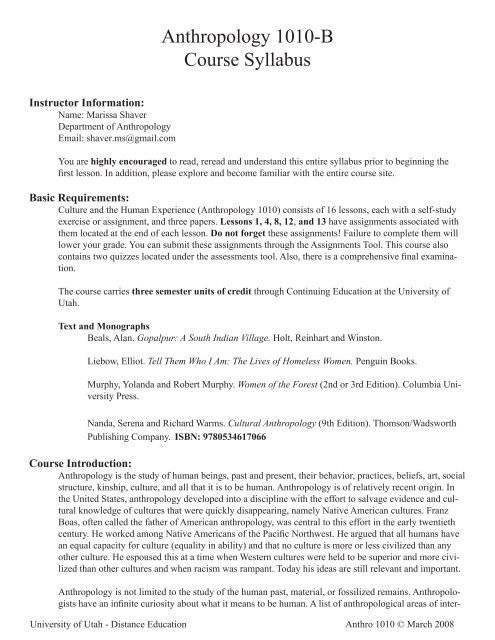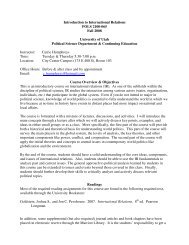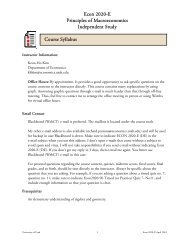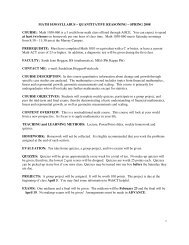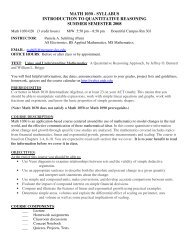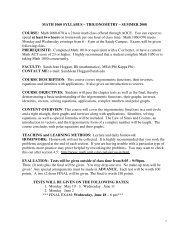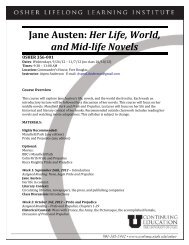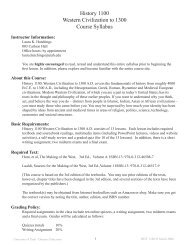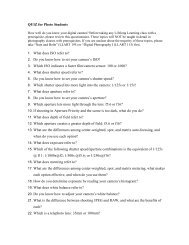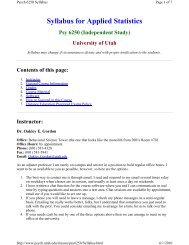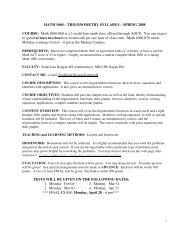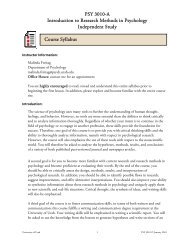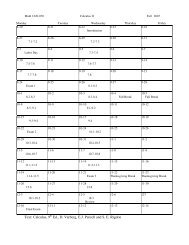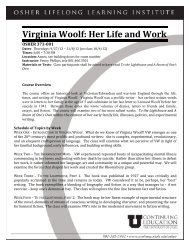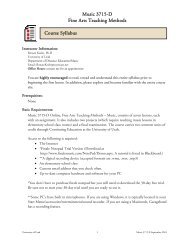Anthropology 1010-B Course Syllabus - Continuing Education at the ...
Anthropology 1010-B Course Syllabus - Continuing Education at the ...
Anthropology 1010-B Course Syllabus - Continuing Education at the ...
You also want an ePaper? Increase the reach of your titles
YUMPU automatically turns print PDFs into web optimized ePapers that Google loves.
<strong>Anthropology</strong> <strong>1010</strong>-B<br />
<strong>Course</strong> <strong>Syllabus</strong><br />
Instructor Inform<strong>at</strong>ion:<br />
Name: Marissa Shaver<br />
Department of <strong>Anthropology</strong><br />
Email: shaver.ms@gmail.com<br />
You are highly encouraged to read, reread and understand this entire syllabus prior to beginning <strong>the</strong><br />
first lesson. In addition, please explore and become familiar with <strong>the</strong> entire course site.<br />
Basic Requirements:<br />
Culture and <strong>the</strong> Human Experience (<strong>Anthropology</strong> <strong>1010</strong>) consists of 16 lessons, each with a self-study<br />
exercise or assignment, and three papers. Lessons 1, 4, 8, 12, and 13 have assignments associ<strong>at</strong>ed with<br />
<strong>the</strong>m loc<strong>at</strong>ed <strong>at</strong> <strong>the</strong> end of each lesson. Do not forget <strong>the</strong>se assignments! Failure to complete <strong>the</strong>m will<br />
lower your grade. You can submit <strong>the</strong>se assignments through <strong>the</strong> Assignments Tool. This course also<br />
contains two quizzes loc<strong>at</strong>ed under <strong>the</strong> assessments tool. Also, <strong>the</strong>re is a comprehensive final examin<strong>at</strong>ion.<br />
The course carries three semester units of credit through <strong>Continuing</strong> <strong>Educ<strong>at</strong>ion</strong> <strong>at</strong> <strong>the</strong> University of<br />
Utah.<br />
Text and Monographs<br />
Beals, Alan. Gopalpur: A South Indian Village. Holt, Reinhart and Winston.<br />
Liebow, Elliot. Tell Them Who I Am: The Lives of Homeless Women. Penguin Books.<br />
Murphy, Yolanda and Robert Murphy. Women of <strong>the</strong> Forest (2nd or 3rd Edition). Columbia University<br />
Press.<br />
Nanda, Serena and Richard Warms. Cultural <strong>Anthropology</strong> (9th Edition). Thomson/Wadsworth<br />
Publishing Company. ISBN: 9780534617066<br />
<strong>Course</strong> Introduction:<br />
<strong>Anthropology</strong> is <strong>the</strong> study of human beings, past and present, <strong>the</strong>ir behavior, practices, beliefs, art, social<br />
structure, kinship, culture, and all th<strong>at</strong> it is to be human. <strong>Anthropology</strong> is of rel<strong>at</strong>ively recent origin. In<br />
<strong>the</strong> United St<strong>at</strong>es, anthropology developed into a discipline with <strong>the</strong> effort to salvage evidence and cultural<br />
knowledge of cultures th<strong>at</strong> were quickly disappearing, namely N<strong>at</strong>ive American cultures. Franz<br />
Boas, often called <strong>the</strong> f<strong>at</strong>her of American anthropology, was central to this effort in <strong>the</strong> early twentieth<br />
century. He worked among N<strong>at</strong>ive Americans of <strong>the</strong> Pacific Northwest. He argued th<strong>at</strong> all humans have<br />
an equal capacity for culture (equality in ability) and th<strong>at</strong> no culture is more or less civilized than any<br />
o<strong>the</strong>r culture. He espoused this <strong>at</strong> a time when Western cultures were held to be superior and more civilized<br />
than o<strong>the</strong>r cultures and when racism was rampant. Today his ideas are still relevant and important.<br />
<strong>Anthropology</strong> is not limited to <strong>the</strong> study of <strong>the</strong> human past, m<strong>at</strong>erial, or fossilized remains. Anthropologists<br />
have an infinite curiosity about wh<strong>at</strong> it means to be human. A list of anthropological areas of inter-<br />
University of Utah - Distance <strong>Educ<strong>at</strong>ion</strong><br />
Anthro <strong>1010</strong> © March 2008
est ranges from <strong>the</strong> more familiar topics of “race,” ethnicity, gender and sex roles, kinship, social organiz<strong>at</strong>ion,<br />
subsistence, political organiz<strong>at</strong>ion to urban studies, gangs, terrorism, ethnomusicology, art and<br />
performance, colonialism, immigr<strong>at</strong>ion, homelessness, labor and class form<strong>at</strong>ion, <strong>the</strong> media, folkhealing<br />
and medical systems or practices, and many more. The range of topics is unlimited.<br />
<strong>Anthropology</strong> involves more than scholarly pursuits. Its tools, methods, and understandings are used to<br />
improve <strong>the</strong> world in which we live. Throughout <strong>the</strong> textbook are boxes titled “<strong>Anthropology</strong> Makes a<br />
Difference.” Here <strong>the</strong> authors assert <strong>the</strong> importance of anthropology in <strong>the</strong> real world. They discuss applied<br />
anthropology - ways in which anthropology has been used to address modern-day problems and<br />
find solutions.<br />
This course is designed to acquaint you with <strong>the</strong> variety and complexity of human life worldwide, and<br />
with <strong>the</strong> tools and methods of cultural anthropology, one of <strong>the</strong> subdisciplines of anthropology. You are<br />
encouraged to pursue your n<strong>at</strong>ural curiosity about cultures and to discover how and why human popul<strong>at</strong>ions<br />
have come to be wh<strong>at</strong> <strong>the</strong>y are.<br />
In this class, all of <strong>the</strong> learning happens outside <strong>the</strong> classroom. Staying with <strong>the</strong> assignments and keeping<br />
me informed of your studies and situ<strong>at</strong>ions will enhance your learning and our rel<strong>at</strong>ionship. Good<br />
luck and I hope you enjoy this course!<br />
Grading Policy:<br />
Your course grade will be determined by <strong>the</strong> following scale:<br />
A = 328 - 350 B+ = 304 - 314 C+ = 269 - 279 D+ = 234 - 244 E < 214<br />
A- = 315 - 327 B = 293 - 303 C = 258 - 268 D = 222 - 233<br />
B- = 208 - 292 C- = 245 - 257 D- = 215 - 221<br />
5 Assignments @ 10 points each<br />
2 Quizzes @ 25 points each<br />
3 Monograph papers @ 50 points each<br />
Final Exam @ 100 points<br />
Total points = 350<br />
<strong>Course</strong> Form<strong>at</strong>:<br />
This course consists of 16 lessons, each of <strong>the</strong>m vital to your understanding of cultural anthropology.<br />
The self-study and assignments portion of <strong>the</strong> lessons must be carefully completed in order for you to<br />
perform well on <strong>the</strong> final examin<strong>at</strong>ion. You do not need to hand in <strong>the</strong> self-study m<strong>at</strong>erial, but you do<br />
need to turn in <strong>the</strong> assignments from lessons 1, 4, 8, 12, and 13. You need to answer only one of <strong>the</strong><br />
questions listed. Assignments should be <strong>at</strong> least 1/2 page in length and no longer than one page doublespaced.<br />
Submit all assignments via <strong>the</strong> assignments tool. You also have two quizzes which are loc<strong>at</strong>ed in<br />
<strong>the</strong> assessments tool.<br />
Most lessons consist of:<br />
1. a short lecture reading<br />
2. a text reading assignment and a monograph reading assignment. Each reading assignment includes a<br />
University of Utah - Distance <strong>Educ<strong>at</strong>ion</strong><br />
Anthro <strong>1010</strong> © March 2008
list of terms which you need to be able to define accur<strong>at</strong>ely and use appropri<strong>at</strong>ely in answering <strong>the</strong> selfstudy<br />
and assignment essay questions, writing <strong>the</strong> monograph papers, and on <strong>the</strong> final exam. The definitions<br />
of <strong>the</strong> terms are in each lesson’s assigned reading in <strong>the</strong> textbook; and<br />
3. a self-study exercise or assignment covering <strong>the</strong> inform<strong>at</strong>ion in <strong>the</strong> lesson. The questions can be answered<br />
in 1/2 to one page, depending on <strong>the</strong> question, so use your judgment, based on <strong>the</strong> readings.<br />
The questions should be answered subjectively and on your own. You should be able to use each lesson’s<br />
listed terms appropri<strong>at</strong>ely in <strong>the</strong> self-study exercises or assignments in order to best prepare you to<br />
use <strong>the</strong>m correctly in <strong>the</strong> three papers and on <strong>the</strong> final exam. After writing your self-study or assignment<br />
answers out, it is a good idea to discuss <strong>the</strong>m with ano<strong>the</strong>r person or explain your answer to ano<strong>the</strong>r<br />
individual. The aim here is to have a working knowledge of <strong>the</strong>se answers and <strong>the</strong> ability to rel<strong>at</strong>e <strong>the</strong><br />
inform<strong>at</strong>ion to ano<strong>the</strong>r person. This will help you when you take <strong>the</strong> final examin<strong>at</strong>ion. Remember to<br />
differenti<strong>at</strong>e <strong>the</strong> self-study questions with <strong>the</strong> assignmets. The assignments can be found in lessons 1, 4,<br />
8, 12, and 13. Submit <strong>the</strong>m via <strong>the</strong> assignments tool in WebCT. Do not submit <strong>the</strong> self-study questions,<br />
only assigment questions in <strong>the</strong> lessons indic<strong>at</strong>ed.<br />
4. There will be two quizzes during <strong>the</strong> course. One midway through <strong>the</strong> course and <strong>the</strong> o<strong>the</strong>r <strong>at</strong> <strong>the</strong> end.<br />
Monograph Papers:<br />
Three monograph papers are required, each worth 50 points. The papers are graded according to <strong>the</strong> folowing<br />
scale:<br />
A = 45-50 B = 40-44 C = 35-39 D = 30-34<br />
Scores below 30 require revision and resubmission. The highest possible grade for a resubmission is a C<br />
(39 points).<br />
Each paper is an in-depth essay (3-5 pages) dealing with a specified topic based on a monograph th<strong>at</strong> is<br />
to be read very thoroughly, cover to cover. You should use inform<strong>at</strong>ion and evidence derived from <strong>the</strong><br />
course m<strong>at</strong>erial and text as well as <strong>the</strong> m<strong>at</strong>erial from <strong>the</strong> self-study exercises and assignments. Before<br />
you begin writing, you should outline <strong>the</strong> essay and make sure you are answering <strong>the</strong> questions <strong>at</strong> hand.<br />
Your opinions and subjective impressions are encouraged. Grades will be determined on <strong>the</strong> basis of accuracy,<br />
completeness, and demonstr<strong>at</strong>ed understanding of <strong>the</strong> questions and reading m<strong>at</strong>erial. The papers<br />
are to be typed and double-spaced with adequ<strong>at</strong>e margins. They must include <strong>the</strong> title of <strong>the</strong> monograph<br />
and your name.<br />
Study Suggestions:<br />
I suggest th<strong>at</strong> you read through all of <strong>the</strong> lessons before you begin in order to get a feel for <strong>the</strong> course as<br />
a whole. I also suggest th<strong>at</strong> you set a realistic goal for completion of <strong>the</strong> course. One lesson a week<br />
seems to be a good ‘guideline’ for most students. One monograph paper every three to four weeks is a-<br />
ppropri<strong>at</strong>e. Experience has shown th<strong>at</strong> long interruptions can dampen enthusiasm for finishing courses<br />
so don’t procrastin<strong>at</strong>e!<br />
Please feel free to contact me with any questions you have regarding <strong>the</strong> lessons and/or assignments. My<br />
email address is listed <strong>at</strong> <strong>the</strong> top of this syllabus.<br />
Internet and Textbook:<br />
This edition of <strong>the</strong> text has an educ<strong>at</strong>ional website th<strong>at</strong> I encourage you to explore. The web content<br />
includes photo essays and film clips for most chapters, which visually demonstr<strong>at</strong>e key concepts. The<br />
University of Utah - Distance <strong>Educ<strong>at</strong>ion</strong><br />
Anthro <strong>1010</strong> © March 2008
text suggests th<strong>at</strong> you access InfoTrac College Edition. Your textbook should come with a password for<br />
a one-month free subscription. The decision to subscribe is yours. I will not include any inform<strong>at</strong>ion<br />
solely found on <strong>the</strong> Internet on <strong>the</strong> final exam. You can purchase <strong>the</strong> text through any online<br />
retailer such as Amazon.com.<br />
To access <strong>the</strong> web content, please visit http://anthropology.wadsworth.com and click on Cultural <strong>Anthropology</strong>,<br />
9th edition.<br />
Final Exam:<br />
The final exam is comprehensive and so covers all course m<strong>at</strong>erial assigned in <strong>the</strong> text and <strong>the</strong> course<br />
m<strong>at</strong>erial. A m<strong>at</strong>ching exercise, short answer, and essay questions are included. You may take <strong>the</strong> final<br />
only after all assignments, quizzes, and both projects have been graded and returned to you. To help you<br />
prepare for <strong>the</strong> exam, a study guide has been provided in WebCT. Allow two hours to take <strong>the</strong> exam.<br />
Again, please feel free to email me if you have any questions during this course.<br />
The final examin<strong>at</strong>ion consists of multiple choice, true/false, short answer, and essay questions. The<br />
most efficient way to study for <strong>the</strong> exam is to fully complete <strong>the</strong> self-study exercises and assignments<br />
because most of <strong>the</strong> exam questions will come from <strong>the</strong>m. You will have two hours to complete <strong>the</strong> final<br />
exam, which is a closed book, comprehensive test. Inform<strong>at</strong>ion on how to arrange to take <strong>the</strong> exam is<br />
loc<strong>at</strong>ed in <strong>the</strong> “Start Here” folder on <strong>the</strong> course home page (Blackboard). Click on <strong>the</strong> “Final Exam<br />
Request” link.<br />
NOTE: Independent Study policy requires th<strong>at</strong> you pass <strong>the</strong> final examin<strong>at</strong>ion in order to pass <strong>the</strong><br />
course. Your grade — whe<strong>the</strong>r passing or failing — will be recorded with <strong>the</strong> University of Utah Registrar.<br />
The graded exam will not be returned to you. You will receive a grade sheet with instructor comments.<br />
If you would like to review your graded exam, please contact <strong>the</strong> Distance <strong>Educ<strong>at</strong>ion</strong> office.<br />
Independent Study Academic Honesty Guidelines:<br />
The University of Utah policy on academic honesty applies to Distance <strong>Educ<strong>at</strong>ion</strong> students. Students<br />
enrolled in University of Utah courses are expected to be aware of <strong>the</strong> seriousness of academic dishonesty.<br />
Unacceptable behavior includes che<strong>at</strong>ing on tests, plagiarism, and collusion. Plagiarism means <strong>the</strong> appropri<strong>at</strong>ion<br />
of any o<strong>the</strong>r person’s work and <strong>the</strong> unacknowledged incorpor<strong>at</strong>ion of th<strong>at</strong> work in one’s own<br />
work offered for credit. Collusion means <strong>the</strong> unauthorized collabor<strong>at</strong>ion with any o<strong>the</strong>r person in preparing<br />
work offered for credit.<br />
Students found engaging in academic dishonesty are subject to a variety of penalties such as resubmission<br />
of assignments, re-examin<strong>at</strong>ion, and failure in <strong>the</strong> course (see PPM Chapter X, Section V: STU-<br />
DENT ACADEMIC CONDUCT, Section B-3 for a complete listing).<br />
Plagiarism is taking ano<strong>the</strong>r person’s ideas or writings and using <strong>the</strong>m as your own. In o<strong>the</strong>r words,<br />
you can’t copy something right out of your textbook and stick it in an assignment which makes it appear<br />
as though you had written it. Instructors generally read <strong>the</strong> text numerous times. Some instructors refer<br />
to <strong>the</strong> text constantly while grading. Th<strong>at</strong> means <strong>the</strong>y are familiar with both <strong>the</strong> content and with <strong>the</strong><br />
style of writing. If an instructor detects plagiarism in an answer, you will be given no credit for th<strong>at</strong> answer.<br />
You may fail th<strong>at</strong> assignment. If you do it again in a future assignment, your standing in <strong>the</strong> course<br />
University of Utah - Distance <strong>Educ<strong>at</strong>ion</strong><br />
Anthro <strong>1010</strong> © March 2008
will go on hold, and you will be referred to <strong>the</strong> director of Distance <strong>Educ<strong>at</strong>ion</strong>. This may also result in a<br />
failing grade for <strong>the</strong> course.<br />
Feel free to contact your instructor for clarific<strong>at</strong>ion on <strong>the</strong> subject of academic honesty. Also feel free to<br />
ask questions while you’re writing your assignments. If you’re unsure about this issue of academic honesty,<br />
or about issues about textbook content, contact your instructor.<br />
Guidelines for Quoting and Paraphrasing:<br />
You can quote or paraphrase from your textbook:<br />
Quoting -<br />
When you copy any phrase or string of words (four or more words in a row) you must<br />
credit <strong>the</strong> author.<br />
Example 1: On page 369, a certain text says th<strong>at</strong> insulin is a “short-term hunger trigger.”<br />
To include this phrase in your answer, credit <strong>the</strong> textbook author:<br />
Insulin is released into <strong>the</strong> bloodstream <strong>at</strong> <strong>the</strong> sight of food and acts as a “short-term hunger<br />
trigger” (Myers, p. 369)<br />
Paraphrasing -<br />
You may reword or paraphrase as long as you do it correctly. You cannot change one or<br />
two words in a sentence and consider th<strong>at</strong> an adequ<strong>at</strong>e paraphrase. Paraphrasing means<br />
th<strong>at</strong> you may use <strong>the</strong> author’s idea, but you must reword <strong>the</strong> sentence completely.<br />
“When a person sees food, insulin is released into <strong>the</strong> bloodstream, and <strong>the</strong> person becomes<br />
hungry.”<br />
You may not use <strong>the</strong> term “short-term hunger trigger” unless you quote it and reference<br />
<strong>the</strong> page. It’s a special and unique phrase coined by textbook author Myers.<br />
Crediting <strong>the</strong> Source - Whe<strong>the</strong>r you quote or paraphrase you must credit <strong>the</strong> source of <strong>the</strong> inform<strong>at</strong>ion. One way<br />
to credit a source is to include <strong>the</strong> author’s last name and <strong>the</strong> page number where <strong>the</strong> passage<br />
can be found.<br />
Example 2: Quote from Fiske and Taylor’s Social Cognition (p. 213): “One’s poor abilities<br />
tend to be perceived as common, but one’s favored abilities are seen as rare and distinctive.”<br />
(Fiske and Taylor, p. 213)<br />
Ano<strong>the</strong>r way to credit an author is to add something such as:<br />
According to <strong>the</strong> authors of <strong>the</strong> text, . . .<br />
Fiske and Taylor argue th<strong>at</strong> . . .<br />
Darley and Gross (1983, cited in Fiske and Taylor, p. x) support <strong>the</strong> idea th<strong>at</strong> . . .<br />
You should not copy entire paragraphs even if you do use quotes. Why not? Well, rarely<br />
is one of <strong>the</strong> assignment questions aimed directly <strong>at</strong> wh<strong>at</strong> <strong>the</strong> text author was writing<br />
about. You often have to integr<strong>at</strong>e <strong>the</strong> m<strong>at</strong>erial, or compare and contrast two concepts or<br />
University of Utah - Distance <strong>Educ<strong>at</strong>ion</strong><br />
Anthro <strong>1010</strong> © March 2008
terms. In o<strong>the</strong>r words you won’t be able to find a whole paragraph th<strong>at</strong> gives exactly <strong>the</strong><br />
answer <strong>the</strong> instructor is looking for.<br />
How to Produce Sterling Written Assignments:<br />
You are about to start a Distance <strong>Educ<strong>at</strong>ion</strong> Independent Study course. It’s quite a bit different from taking<br />
a traditional, classroom lecture-type course, so you may be wondering wh<strong>at</strong> it is you’ll have<br />
to do in order to pass this class. Well, this part of <strong>the</strong> course manual contains hints th<strong>at</strong> you should<br />
incorpor<strong>at</strong>e while preparing assignments. Glance over this m<strong>at</strong>erial before doing your first assignment.<br />
When completing written assignments:<br />
1. Refer to both <strong>the</strong> text and to commentary in this course manual. Remember to cite references properly.<br />
Don’t forget while answering questions th<strong>at</strong> <strong>the</strong>re could be relevant m<strong>at</strong>erial in <strong>the</strong> course manual<br />
as well as in <strong>the</strong> textbook.<br />
2. When giving examples, come up with your own examples r<strong>at</strong>her than using <strong>the</strong> ones from <strong>the</strong> text.<br />
You’ll learn <strong>the</strong> m<strong>at</strong>erial much, much better if you have to think of how to apply wh<strong>at</strong> you’ve learned<br />
in a new way.<br />
3. Remember to address each and every part of a question. Many students answer <strong>the</strong> first part of a twoor<br />
three-part question, forgetting to comment on <strong>the</strong> rest of wh<strong>at</strong> was asked. You can only receive full<br />
credit for answering <strong>the</strong> whole question.<br />
4. Go into enough depth to carefully answer each and every part of <strong>the</strong> question being asked. Do not go<br />
overboard. Be concise, but be thorough. Essay answers will necessarily vary in length as a function of<br />
wh<strong>at</strong>’s being asked. Your answers should most often be between about one-third and one-half of a<br />
page in length. One short paragraph containing a few sentences will probably never be sufficient,<br />
while answers th<strong>at</strong> exceed one page in length may be too wordy or go into more detail than needed.<br />
5. Organize your answer. An essay with a proper introduction, body and conclusion generally provides<br />
more understanding (hence a better grade) than an essay th<strong>at</strong> is not structured. It’s easier for a reader<br />
to follow your train of thought when your answer is laid out clearly. The brief introduction should let<br />
<strong>the</strong> reader know <strong>the</strong> n<strong>at</strong>ure of <strong>the</strong> answer — your <strong>the</strong>sis and agenda. Within <strong>the</strong> body of <strong>the</strong> essay, address<br />
each and every part of <strong>the</strong> question one <strong>at</strong> a time, being careful to make <strong>the</strong> necessary connections<br />
between each point. The conclusion should tie things toge<strong>the</strong>r and remind <strong>the</strong> reader of <strong>the</strong> central<br />
point(s).<br />
You may not think th<strong>at</strong> <strong>the</strong> way you write should be counted toward your grade. But if your reader can’t understand<br />
wh<strong>at</strong> it is you’ve written, <strong>the</strong>n you’ve essentially failed to communic<strong>at</strong>e th<strong>at</strong> you have <strong>the</strong> right answer.<br />
This may neg<strong>at</strong>ively affect your grade. Since Independent Study classes have a tremendous emphasis on written<br />
work, writing style is especially important. Review this section before you hand in an assignment. NOTE:<br />
Spelling, punctu<strong>at</strong>ion and sentence structure are all part of writing style.<br />
Final Step: Read It Out Loud.<br />
If you’re not sure th<strong>at</strong> your sentence is gramm<strong>at</strong>ically correct, try reading it out loud. If it doesn’t sound right,<br />
<strong>the</strong>n it probably isn’t correct gramm<strong>at</strong>ically.<br />
University of Utah - Distance <strong>Educ<strong>at</strong>ion</strong><br />
Anthro <strong>1010</strong> © March 2008


